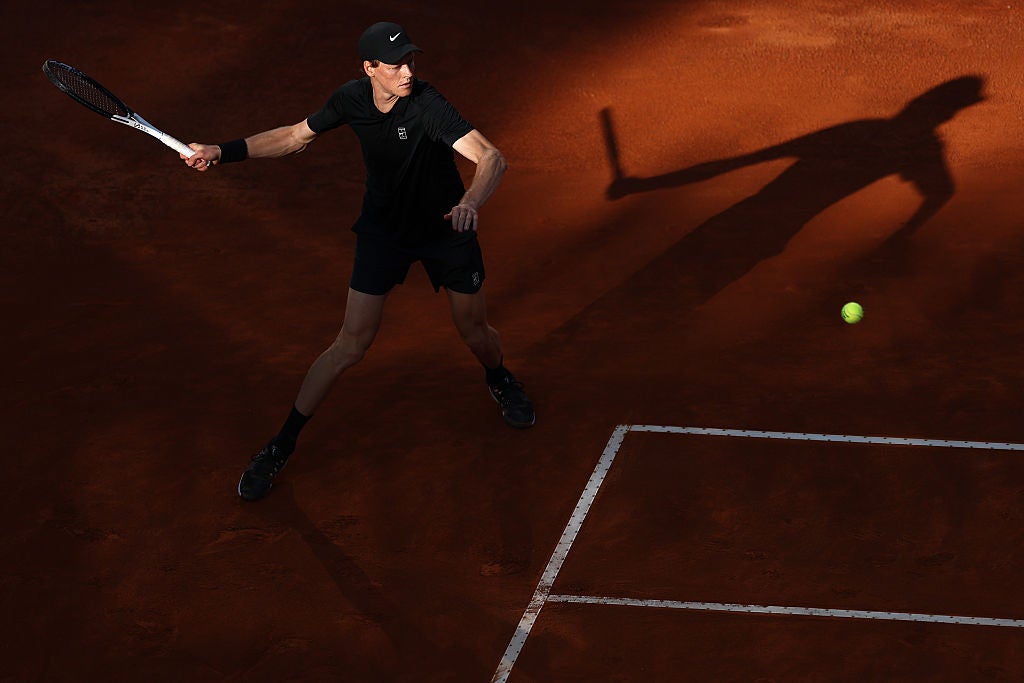It was one of those matches even a scriptwriter wouldn’t write. Jannik Sinner, the home hero, marching through Rome. Adoring crowds. A raucous atmosphere. And the world No 1 back on his perch.
While he was allowed to train during his doping suspension, it seemed reasonable to expect him to lack his usual sharpness on his return to competition. That was evident on some occasions – notably a surprise 1-6 first-set loss in his semi-final against Tommy Paul – but not on others. As he eviscerated Casper Ruud, the most recent Masters 1000 champion and a natural clay-courter, it was like he had never left.
Sinner has one of the most complete games on the tour, but it is his mental strength which sets him aside. The news of his positive doping tests at Indian Wells last year emerged on the eve of the US Open. Amid a media firestorm and open revolt by many of his competitors – on social media at least, if not to his face – he maintained his composure and bulldozed his way to the title. Similar circumstances surrounded his Australian Open title defence, with a legal case against Wada on the horizon and a potentially career-ruining two-year ban. His run in Melbourne was quiet and ruthless, business as usual from one of the tour’s most methodical characters.
The closest comparison is to Iga Swiatek, also a top-ranked player and a similarly dominant figure until her own one-month suspension for taking medication contaminated with trimetazidine. She has not won a title since her Roland Garros triumph last year, falling out of the top two for the first time in three years with an early exit in Rome, and has become increasingly prone to on-court meltdowns, her frustration at losing control of a point or game often boiling over.
She has been open about the stress of the suspension and the public response to it, and it seems she cannot shake the lingering damage. Sinner, while he admitted he considered quitting tennis during his suspension, has had no such slide in form, and arrived in Rome a more relaxed and expressive figure than normal. He seems determined to put the past behind him.
But even as he moved relatively smoothly through the Rome draw, it was obvious that a final against Carlos Alcaraz was always going to be a tougher challenge.
Alcaraz leads their head-to-head 7-4, having won their last four meetings in succession. Half of Sinner’s remarkably small number of losses in 2024 were to the Spaniard, including a semi-classic in the Beijing final, which required a final-set tiebreak to settle a superb contest. Ironically, despite both being such formidable talents, their matches – 2022 US Open quarter-final aside – often haven’t been that exciting, as each has neutralised the other.
.jpeg)
It’s almost like it took Sinner coming back for Alcaraz to rediscover his best tennis, the pressure no longer on him to close the gap to the Italian, but back on the world No 1 to conserve his status in a sport that has moved on, in certain intangible ways, in his three months away. Alcaraz has openly admitted that the pressure to make the most of Sinner’s absence got to him, and he lost ground in the ATP race.
But playing on a surface he particularly excels at, and one which is a comparative weak spot in Sinner’s game, Alcaraz was back to his thrilling, varied, inventive best. His 7-6 (5), 6-1 win at the Foro Italico secured the clean sweep of every major clay title for the 22-year-old and marked the culmination of a match in which he was able to maintain focus and stick to his tactics, without the dips in form that have characterised much of his year so far.
Get 3 months free with ExpressVPN
Servers in 105 Countries
Superior Speeds
Works on all your devices
Try for free
ADVERTISEMENT. If you sign up to this service we will earn commission. This revenue helps to fund journalism across The Independent.
Get 3 months free with ExpressVPN
Servers in 105 Countries
Superior Speeds
Works on all your devices
Try for free
ADVERTISEMENT. If you sign up to this service we will earn commission. This revenue helps to fund journalism across The Independent.
The pair are intriguing foils, on and off the court. It is obvious there is a mutual respect and liking, if not quite friendship, between them. Sinner has the consistency and power to dismantle opponents week in and week out; Alcaraz has arguably the bigger arsenal but lacks the same utter concentration and ruthlessness on court.

At the moment, it feels like Alcaraz’s greater variety, and ability to disrupt Sinner’s rhythm, is making the difference. How Sinner reacts in the coming months will be fascinating to watch.
The upcoming French Open throws up more questions. Sinner’s hero’s welcome in Rome was to be expected. It seems likely that that response will be more muted elsewhere, but if it tips into hostile – the Roland Garros crowds are infamously not shy of making their feelings known – how he responds will be fascinating. How he holds up to the rigours of best-of-five tennis is another unknown.
But on the eve of the year’s second major, it feels like the balance of power within tennis has shifted again. Sinner’s return has almost emboldened Alcaraz, taken the weight off his shoulders and enabled him to play freely. Like all great rivals, they push each other to be better.
Two questions remain. Can any of their lesser rivals raise their game to combat them? And which of the pair will emerge on top?


